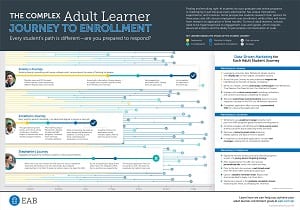Impressions. CTR. Conversions.
Sometimes marketing jargon can feel like another language.
This was top of mind for me as I pored over the results of our recent survey of deans. Over half of these deans told us they anticipate marketing will become more decentralized in the next two to three years. If deans expect to take on marketing responsibilities on top of their existing academic and operational obligations, their unfamiliarity with marketing terms poses a problem.
And it’s not just deans. Across hundreds of campus visits, I’ve found that most administrators outside of marketing and enrollment departments can’t answer questions about their marketing metrics or costs.
Monitoring and responding to these metrics is especially critical when recruiting prospective students of graduate, online, certificate, and undergraduate degree completion programs. These adult learners have their own motivations, goals, and timelines—their own unique student journey. The key is to know which metrics to track, when, and how to respond.
Monitor impressions to track brand awareness
One way to track brand awareness is through impressions. An impression is a view of a page or ad. It takes about five to seven impressions for a consumer to remember a brand. That’s why we’re always thinking about how to reach a large audience, but also the right audience. With our Adult Learner Recruitment clients, we use machine learning to identify the prospective adult learners most similar to your student body profile. This approach allows us to get to know prospects and design ads which build genuine connections between our clients and these students. At the awareness stage, personalized marketing is key to making those five to seven impressions stick.
But you don’t want to overspend when creating ads for prospects in the awareness stage. Those prospects could still be a long way away from application. Facebook newsfeed ads, like the one below, are a low-cost way to get your ad in front of a large audience. My kids would roll their eyes at the mere mention of Facebook. But while only about half of U.S. teens use Facebook, seven in 10 adults do, according to Pew. Seventy-four percent of those users log into Facebook daily, making Facebook an easy way to raise awareness of your programs.

Use click-through rate and open rate to understand what works
Next, you want to track if and how prospective students are engaging with your ads and emails. Click-through rate is the total number of clicks divided by the total number of impressions. It’s a quick way to tell which messages are resonating most with prospects.
Open rate is the number of times your email is opened divided by the total number of times the email is sent. Sometimes the most effective emails in the consideration stage don’t require a click. We’ve partnered with clients to create a monthly newsletter filled with content about faculty, students, and program accolades for alumni who indicate interest in graduate programs. Our newsletters on average see a 47% open rate, well above industry averages. Emails should be skimmable and digestible, so readers have a positive experience with your brand and are more likely to open your next email.
Look to conversion rates to track leads
See how we helped a graduate school increase leads while reducing marketing spend
Read the BlogYou can’t forget about prospects who are ready to move past the consideration stage and take action. Conversion rate is the percentage of prospects who complete a desired action. One conversion rate we monitor is impression to lead rate. A prospect becomes a lead when they show interest in your program, perhaps by filling out your request for information form. Other conversion rates to monitor include lead to application and application to enrollment.
To drive conversions in the “decision” stage, we work with our clients to send customized LinkedIn InMail to prospective students. This highly personalized touch at the decision stage shows prospective students that you’re invested in their journey.
Sometimes schools hesitate to use LinkedIn because of cost. We’ve found using geographic parameters and one to two targeting criteria aligned with clients’ programs helps our partners get the most from their LinkedIn investment.
Monitor cost at all stages
Your marketing isn’t effective if it’s consuming too much of your budget. Marketing metrics like cost necessary to acquire a lead and cost per enrollment aren’t only essential in the short term, but also in the long-term success of your adult-serving programs.



